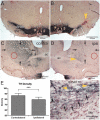The neurotoxicity of DOPAL: behavioral and stereological evidence for its role in Parkinson disease pathogenesis
- PMID: 21179455
- PMCID: PMC3001493
- DOI: 10.1371/journal.pone.0015251
The neurotoxicity of DOPAL: behavioral and stereological evidence for its role in Parkinson disease pathogenesis
Erratum in
- PLoS One. 2011;6(2). doi: 10.1371/annotation/819cbf4a-7e3e-4e4e-a449-b667bc6e8957
Abstract
Background: The etiology of Parkinson disease (PD) has yet to be fully elucidated. We examined the consequences of injections of 3,4-dihydroxyphenylacetaldehyde (DOPAL), a toxic metabolite of dopamine, into the substantia nigra of rats on motor behavior and neuronal survival.
Methods/principal findings: A total of 800 nl/rat of DOPAL (1 µg/200 nl) was injected stereotaxically into the substantia nigra over three sites while control animals received similar injections of phosphate buffered saline. Rotational behavior of these rats was analyzed, optical density of striatal tyrosine hydroxylase was calculated, and unbiased stereological counts of the substantia nigra were made. The rats showed significant rotational asymmetry ipsilateral to the lesion, supporting disruption of dopaminergic nigrostriatal projections. Such disruption was verified since the density of striatal tyrosine hydroxylase decreased significantly (p<0.001) on the side ipsilateral to the DOPAL injections when compared to the non-injected side. Stereological counts of neurons stained for Nissl in pars compacta of the substantia nigra significantly decreased (p<0.001) from control values, while counts of those in pars reticulata were unchanged after DOPAL injections. Counts of neurons immunostained for tyrosine hydroxylase also showed a significant (p=0.032) loss of dopaminergic neurons. In spite of significant loss of dopaminergic neurons, DOPAL injections did not induce significant glial reaction in the substantia nigra.
Conclusions: The present study provides the first in vivo quantification of substantia nigra pars compacta neuronal loss after injection of the endogenous toxin DOPAL. The results demonstrate that injections of DOPAL selectively kills SN DA neurons, suggests loss of striatal DA terminals, spares non-dopaminergic neurons of the pars reticulata, and triggers a behavioral phenotype (rotational asymmetry) consistent with other PD animal models. This study supports the "catecholaldehyde hypothesis" as an important link for the etiology of sporadic PD.
Conflict of interest statement
Figures




References
-
- Eriksen JL, Dawson TM, Dickson DW, Petrucelli L. Caught in the act: α-synuclein is the culprit in Parkinson's disease. Neuron. 2003;40:453–456. - PubMed
-
- Terzioglu M, Galter D. Parkinson's disease: genetic versus toxin-induced rodent models. FEBS J. 2008;275:1384–1391. - PubMed
-
- McCormack AL, Atienza JG, Langston JW, Di Monte DA. Decreased susceptibility to oxidative stress underlies the resistance of specific dopaminergic cell populations to paraquat-induced degeneration. Neuroscience. 2006;141:929–937. - PubMed
-
- Betarbet R, Sherer TB, MacKenzie G, Garcia-Osuna M, Panov AV, et al. Chronic systemic pesticide exposure reproduces features of Parkinson's disease. Nat Neurosci. 2000:1301–1306. - PubMed
Publication types
MeSH terms
Substances
LinkOut - more resources
Full Text Sources
Medical
Miscellaneous

